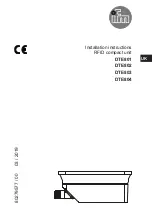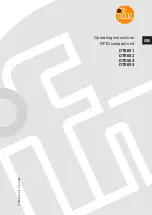
11
2.7 Safety inspections by competent
persons
Safety inspections must be carried out to guar-
antee the safety of lifts.
Safety inspections should be carried out in the
following cases:
•
Before initial operation, after initial installation.
Use the form "Initial safety inspection before in-
stallation“.
•
After initial operation at regular intervals, but at
least once a year. Use the form "Regular Safety
Inspection“.
•
After any design modification to parts of the lift.
Use the form "Unscheduled Safety Inspection“.
i
i
i
The initial safety inspection as well as the
safety inspections must be carried out by a
competent person
. We recommend that
you also perform maintenance in the course
of the inspection.
Unscheduled safety inspections and spec-
ial maintenance work are required in the
event of design modifications to the lift
(fitting additional parts). The safety inspe-
ction must be carried out by a
competent
person.
Use the form supplied in the Annex con-
taining lists for carrying out safety insp-
ections. Please use the relevant form and
staple it to the manual after completion.
2.8 Obligations of the plant operator
Operation of lifting platforms
In Germany,the use of lifting platforms is governed
by the mandatory "Employers' liability insurance
association regulations on health and work safety
as defined in DGUV-100-500(before BGR 500 )
Section 2.10". In all other countries, the applicable
national regulations, laws and directives must be
observed.
Checking of lifting platforms
Checks are to be based on the following directives
and regulations:
•
Basic principles for testing lifting platforms
(DGUV-308-002 before BGG 945)
•
The basic health and safety requirements
stipulated in the directive 2006/42/EC
•
Harmonized European standards
•
The generally acknowledged rules of engineering
•
The directive on the use of equipment 89/655/
EEC and changes with Directive 95/63/EC.
•
The applicable accident prevention regulations
The checks are to be organized by the user of the
lifting platform. The user is responsible for appointing
an expert or qualified person to perform checking. It
must be ensured that the person chosen satisfies the
requirements of BGG 945 as per Section 3.
i
The user bears special responsibility if em-
ployees of the company are appointed as
experts or qualified persons.
Scope of checking
Regular checking essentially involves performing a
visual inspection and a functional test. This includes
checking the condition of the components and equip-
ment, checking that the safety systems are complete
and functioning properly and that the inspection log
book is completely filled in.
The scope of exceptional checking depends on the
nature and extent of any structural modification or
repair work.
Regular checking
After initial commissioning, lifting platforms are to
be checked by a
qualified person
at intervals of not
longer than one year.
A qualified person
is somebody with the training and
experience required to possess sufficient knowledge
of lifting platforms and who is sufficiently familiar with
the pertinent national regulations, accident prevention
regulations and generally acknowledged rules of en-
gineering (e.g. BG rules, DIN Standards, VDE provisi-
ons, the technical regulations of other European Uni-
on member states or other parties to the agreement
in the European economic area) to be able to assess
the safe operating condition of lifting platforms.














































